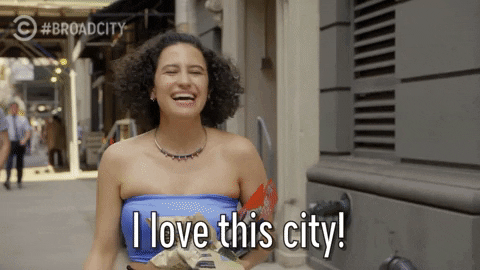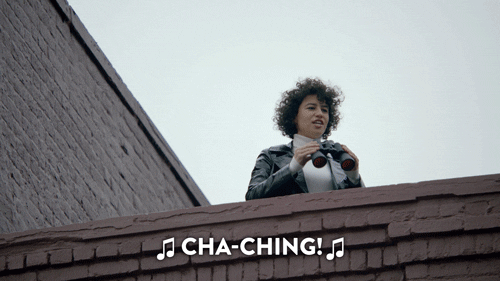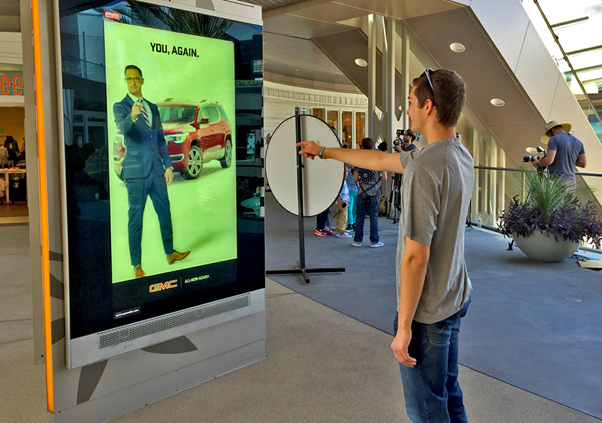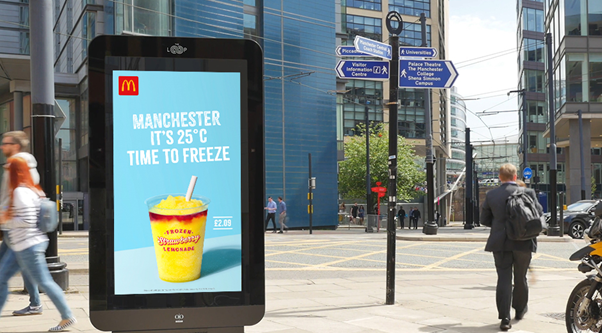"Wait, you want me to look at a billboard?" I hear you say. "Who do you think I am, a 1950s housewife shopping for Jello molds? No way, I'm a cool and trendy 21st Century consumer. I only get my product recommendations from AI-generated reviews beamed directly into my irises, thank you."
Well, what would you say if I told you we can combine these out of home experiences, and digital strategies? I know, I know. It's madness. But it's real.

This year, digital out-of-home advertising is forecasted to capture 40% of OOH ad spending, making out of home (OOH) the only traditional advertising category that's still growing strong.
"The outdoor-advertising business... despite being one of the world’s oldest forms of marketing is embracing digital technologies", reports the Economist. So, what's the power of Digital out-of-home (or DOOH)?
OOH Good, DOOH Better.
52% of consumers report paying attention to OOH, with 81% of urban audiences taking action after seeing OOH advertising.
But first up, what's the difference between OOH and DOOH?
Apart from one being the sound of someone spilling hot tea on themselves, and the other being Homer Simpson's Catchphrase, of course.
Well:
- Out-of-home advertising is traditional outdoor advertising. This is all about messaging to consumers when they are in public places, commuting to work, waiting around, or in specific commercial locations. Think anywhere someone might happen to look up from their phone for three seconds to avoid walking into a lamppost.
- Digital out-of-home advertising is basically this plus ten. DOOH powers OOH with AdTech; geofencing, tracking, retargeting, personalising, attribution and measurement.
Some examples of basic DOOH include:
- Digital display Wi-Fi hotspot kiosks in major cities.
- A dynamic display of hotels advertisements played on screens in airport arrival halls
- Food chain offers on ads played in or near a food court
Moving from OOH to DOOH.
This might mean billboards which dynamically display ads targeted to each individual as they walk past.
This'll be real-time marketing on another level, with billboards that change based on the time of day or weather condition. Imagine ads sold in real-time auctions, and displayed in a specific location in a matter of minutes.
"Today, as people take their purposeful trips there is less distraction and noise," Gilad Amitai, Ubimo's COO and co-founder, wrote on the blog of parent company Quotient.
"Brands can reach consumers with little distraction in the critical moments before they make their purchasing decisions."
Amitai also notes that OOH gives marketers the distinct opportunity to reach customers just before they go into a relevant venue, where they'll make a purchase. So, even traditional OOH is giving a level of location-based personalisation, only made more effective with DOOH, and the data it uses and provides.

So, with the intelligence of DOOH, and the effectiveness of OOH, there's a winning combination.
That's likely why DOOH made up 28.3% of all OOH ads, and is predicted to reach 38.3% in 2023. In fact, DOOH was the main reason for the growth of OOH advertising worldwide in recent years.
Better and more accurate data is the backbone to these innovations. Marketers can offer media based on the demographics and behaviour of mobile devices, and their human counterparts, in real-time.
"Real-time advertising is critical, but in reality, it is part of a growing trend in which the industry is becoming a more reactive solution," suggests James Ewen of Tamoco.
"The large amount of data that marketers now have at their disposal is fuelling this. This versatility is driving OOH personalization and leading to fantastic results for advertisers that are using DOOH to achieve their goals."
So, how do you do DOOH?
The key difference between OOH and other mediums is the availability of location-based marketing. OOH catches potential customers unawares, while they're out, about, and living their lives.
So, your message becomes a powerful interaction between your brand and your target customer. It's an interaction, and an experience. There's less noise too, so you're not competing to shout over your competitors. It's just you, your customer, and whatever amount of rats their city has.
“OOH offers audience reach opportunities unsurpassed in the media landscape, particularly reaching young and upmarket audiences," suggests Talonoutdoor.com
"The blurring of media boundaries, epitomised by the digital OOH landscape and the rise of mobile, should offer smarter solutions to brands feeling the pinch or exploiting consumer sentiment opportunities, particularly those targeting millennial audiences and expecting an immediate response,”
To make the most of your D/OOH campaign, you need to employ data. One example is knowing how many people in your target audience have interacted with your ad. This can be achieved, in one way, through geofencing.
Geofencing marketing is a location-based marketing technique which allows you to connect with smartphone users in a designated geographic area, such as a store, through mobile apps, or mobile webpages.
Geofencing is a way for you to speak directly to your ideal customer, when they use their smartphones in places they frequent.
So, when it comes to combining OOH and DOOH, it's best done in places with lots of people, and consequently lots of phones. This might be an airport, cinemas, shopping centres, or train stations.
Combined with geofencing, these crowded areas will allow you access a bunch of people, and narrow them down to the correct audience, who you can then target with the right content. And targeting the right people, at the right time, with the right content? Well, that means an increase in ROI, of course.

Basically, DOOH offers new opportunities for targeting, in a field which benefits from intelligent consideration of customer location. Knowing who is active in an area can mean your creatives can align themselves with qualified and valuable customers.
Linking data from mobile ad exchanges or by using App data, marketers can analyse consumer movement after exposure to the campaign, to assess the impact on footfall.
In summary, the rich and complex data now available through the explosion of mobile devices and the data trails they leave, means that DOOH planning can be done to a high level of sophistication. Data-led, dynamic ad-service tech can optimise digital OOH content in real time.
Gomodigital.co.uk suggests these three steps for applying, and collecting, data in DOOH campaigns:
- "Where are they?": Target customers in a set geographic location, with defined boundaries, optimised for accurate location-based data.
- "Who are they?": Real-time targeting, based on specific demographics. This might be purchase behaviour and consumption habits, or more personal, such as age, gender or income.
- "Where have they been?": Retarget customers based on history of past visits to a physical location.
However, DOOH still relies on having access to high footfall areas, where inventory is available. Luckily, inventory is constantly being expanded. In fact, there was a 25% growth in DOOH inventory in Bristol last year, and a 43% growth in DOOH inventory in Liverpool.
So, how do you make the most out of your DOOH?
Now you've done the most with your data, you'll need to know how to make sure your efforts get noticed. Some ways of making the most of your DOOH can be:
- Encouraging social interactions. This might mean adding a social element to your OOH, extending that interaction. This could be a call to action, an Instagram handle, or a QR code.
- Full-motion. This might be short movies, news, or sports highlights - even original content made specifically for the locations.
- Using hyper-targeting. OOH planning systems don't just use data like location, but also online browsing behaviour and shopper purchase records. This means being able to target micro-specific segments.
- Consider Multi-screens. A larger multiscreen ecosystem that amplifies brand messages can create a deeper level of engagement with active customers, for a longer period of time while they're out and about.
Right, time for some examples.
We've talked about how OOH benefits from rich data. But who's doing it best?
Acadia SUV, GMC.
In a display of 'Interactive Personalised Content', GMC used facial analytics tech and proximity based marketing to create engaging digital signage featuring dynamic content.

The cameras in the display used AI to detect audience demographics, and then served one of 30 possible targeted ads to the viewer. So if a group had kids, then they'd be shown an ad targeted at families.
The novelty encouraged people to interact with the ad, which then triggered the sign to engage them with interactive games.
So, the campaign used the power of DOOH to personalise their content, and used targeted messaging in a way that gained meaningful and enthusiastic audience engagement.
McCafe, McDonald's.
The McDonald's campaign is an example of OOH featuring dynamic content. The campaign used weather data to advertise seasonal drinks.

When the temperature rose above 22 degrees Celsius, the relevant campaign played on the digital sign - either a strawberry lemonade, or a "Millionaire's Frappe".
If the temperature hit above 25 degrees Celsius, the creative automatically updated to include the city name and current temperature
Lexus
In this case, Lexus used an algorithm to match passing vehicle information with environmental information, such as local traffic and weather conditions, to generate 8- variations of the same ad.

The billboards could tell what type of car a passer-by had, and would tailor a personalised message. This might look like: "Hey black Merc driver, the heavens have opened. This is the new Lexus."
